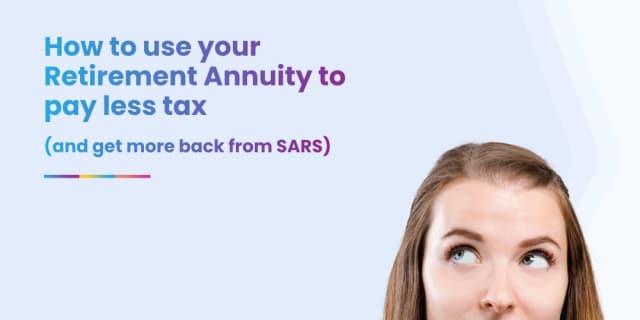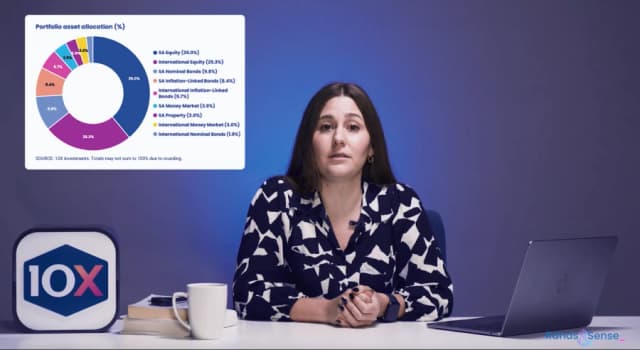How your expensive and underperforming RA is wrecking your retirement - Moneyweb & 10X
Simon Brown
11 February 2025
Many South Africans rely on their retirement annuity (RA) to build financial security, but as we discussed in our recent webinar, high fees and poor performance can significantly impact long-term savings. If you missed the session, the full recording is now available - offering valuable insights for anyone looking to make the most of their retirement investments.
Hosted by MoneywebNOW’s Simon Brown and 10X Investments, the webinar explored the common challenges of traditional RAs and outlined how a low-cost, high-growth strategy can help investors achieve better outcomes. If you're uncertain whether your RA is working in your best interest, this discussion provides the clarity you need. It focuses on:
- How fees impacts your retirement savings over time
- What performance benchmarks you should be tracking
- Are there more effective investment options to consider
Unsure of how much you should be saving after watching the webinar? Use our calculator to get an idea of how much you would need and if you are on the right track.

A well-structured RA should support and not hinder your financial goals. Watch the full recording now to gain expert insights and take control of your retirement strategy.
Key Moments from the Webinar:
[01:07] The 1994 RA Mistake
Simon recounts purchasing his first RA in 1994, influenced by his mother and broker. Despite starting early, he discovered many years later that excessive fees had reduced the product’s value to almost nothing.
Michael agrees: while early products were problematic, high fees still persist today, sometimes reaching levels of 26% in year one.
[03:00] The Compounding Cost of Fees
Michael explains how even “small” fees of 2–3% can erode up to 40–60% of your retirement value over time. He emphasises two key issues:
- Understanding the full impact of fees, and
- Getting 100% fee disclosure using the term EAC (Effective Annual Cost).
Tip: Always ask your provider for the EAC. It’s the only reliable way to ensure full fee transparency.

[06:00] Front-Loaded Fees: Why They’re Dangerous
Simon highlights that some RA's charge large upfront fees e.g., 26% in year one. These fees affect your most powerful compounding years, making them especially destructive.
Michael warns: Fees also compound negatively.
[07:55] What is a “Fair” Fee?
Michael provides a rough gauge:
- Low-cost: ~1% or less
- Medium-cost: 1.5–2.5%
- High-cost: 3% and above (some reaching up to 26%)
Value for money matters, so always assess net returns, not just fees.
[10:02] Judging RA's on Long-Term Performance
Short-term returns (1–3 years) are misleading. RA portfolios are built to perform over 5–10+ years. Use the right timeframes when evaluating your RA’s success.
[10:50] Are You Getting Value from Your Advisor Fee?
Simon and Michael discuss how some advisors add immense value (estate planning, regular reviews), while others disappear post-signature. Only pay if value is delivered not just promised.
[12:36] Switching from a Bad RA: Is It Worth It?
Yes, but evaluate the exit penalty:
- No/few penalties → Easy decision
- Small penalties (2–4%) → Typically recouped in 1–3 years
- Large penalties (10–20%) → Might take a decade to recover
Simon shares how he negotiated his 30% exit penalty down to 12%, making it worthwhile.
[17:04] Are Fees Creeping Back In?
Michael notes that while fees have generally come down over time, some low-cost providers who dropped fees too aggressively are now reinstating them. Be wary of new fees like platform fees creeping in via T&Cs.
[19:32] Are RA's Still a Good Product?
Simon says yes, structure matters.
Benefits include:
- Forced saving (no access before 55)
- Major tax advantages
- Solid legislative backing through Reg 28
[21:03] Total Return = Investment Return + Tax Benefit
Michael urges investors to compare total return (not just investment performance). For example, a 1% return + a 31% tax rebate = 32% total return in year one. Even “underperforming” RA's may outperform other investments after tax.
[23:35] But Don’t I Pay Tax When I Retire?
Yes, but:
- You often earn less at retirement, paying a lower tax rate
- You get R550k tax-free on withdrawal
- Growth within RA's is tax-free until retirement
[25:19] Offshore Limits in Reg 28: Still an Issue?
Michael explains the history behind Reg 28:
- Introduced in 2008 due to poor offshore returns
- Originally capped offshore at 25%
- Increased to 45% in 2022 for flexibility
- Most fund managers don’t use the full 45%, due to valuations
[29:20] Boosters and Bonuses: Smoke and Mirrors?
These marketing tactics can obscure the real cost of the product. Simon compares it to retail gimmicks; "Buy one get one free. Michael suggests comparing the “vanilla” version of the product to the “enhanced” one to see if the extras are truly valuable.
[32:14] How Much Should You Be Saving?
Michael shares general guidance:
- 20s–30s: Save 10–15% of your income
- Earlier is better: Compounding and tax returns do most of the work
- A classic example: Jack saves for 10 years starting at 20, Jill for 35 years starting at 30 - Jack still ends up with more
Every person and their circumstances are different however, so the best way to determine how much you need to save is to use an RA calculator.

[36:48] Is It Too Late to Start at 50?
Not at all. You may need to contribute more, but:
- SARS will still give you a tax return
- Markets still offer compounding growth
- You can still double your money in 8–10 years with the right approach
[39:23] Two-Pot System: What You Need to Know
From 1 September 2024:
- Contributions split: ⅓ savings pot (accessible), ⅔ retirement pot (locked in)
- One-time “seed” amount of 10% (up to R30,000) added to your savings pot from your existing RA
- Accessing savings triggers tax at your marginal rate
- Don’t assume the savings portion is held in cash—it’s still invested.
[43:40] Summary: What To Do About a Bad RA
Wrap up checklist:
- Understand the RA’s purpose: long-term investing + tax benefits
- Ask for your EAC to get full disclosure
- Evaluate net returns, not just performance
- If necessary, consider switching - even with penalties
- Don’t fall for marketing fluff (boosters, bonuses)
- Leverage the two-pot system carefully
- It’s never too late to start saving
Before making any decisions about your current or future RA, it's worth running the numbers. A good RA calculator can help you understand how much you need to contribute, how fees impact your returns, and whether you’re still on track to retire comfortably.
Seeing the projections in black and white can be a powerful motivator and a useful reality check. Don’t rely on guesswork when your future is at stake. Use a calculator, ask for your EAC, and make your retirement work for you.
Related articles
How can we 10X Your Future?
Begin your journey to a secure future with 10X Investments. Explore our range of retirement products designed to help you grow your wealth and achieve financial success.


